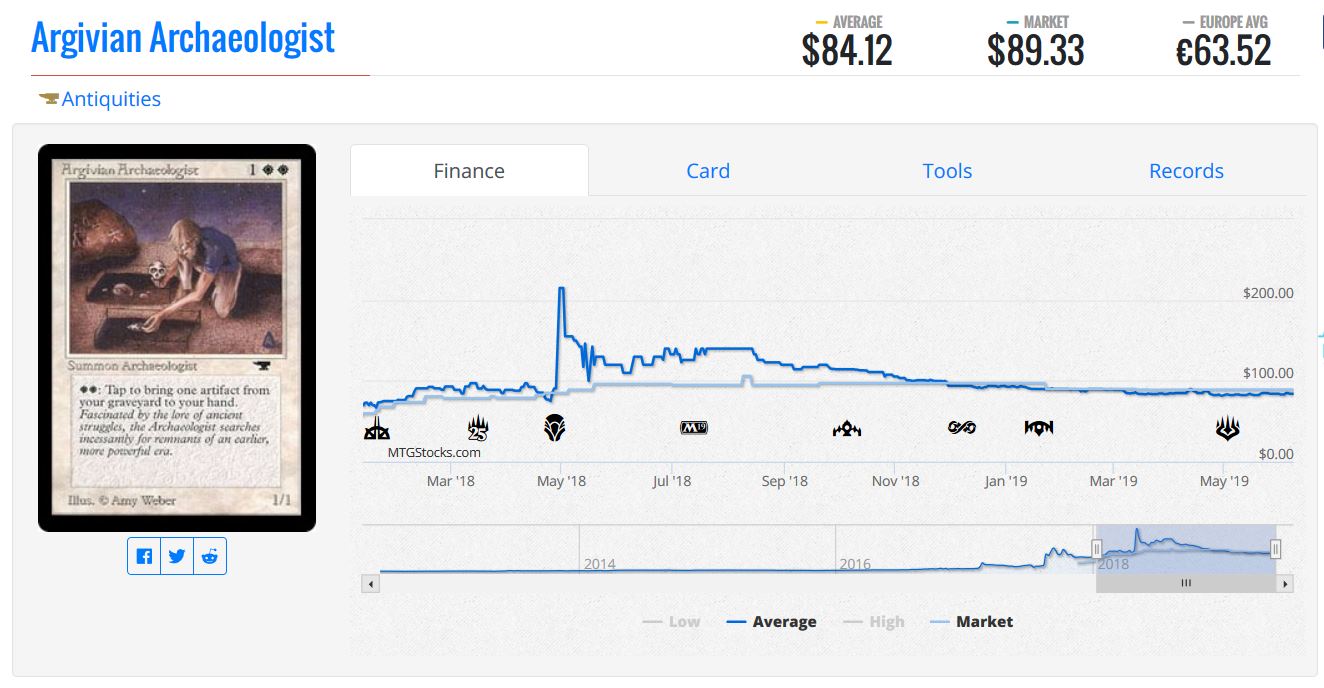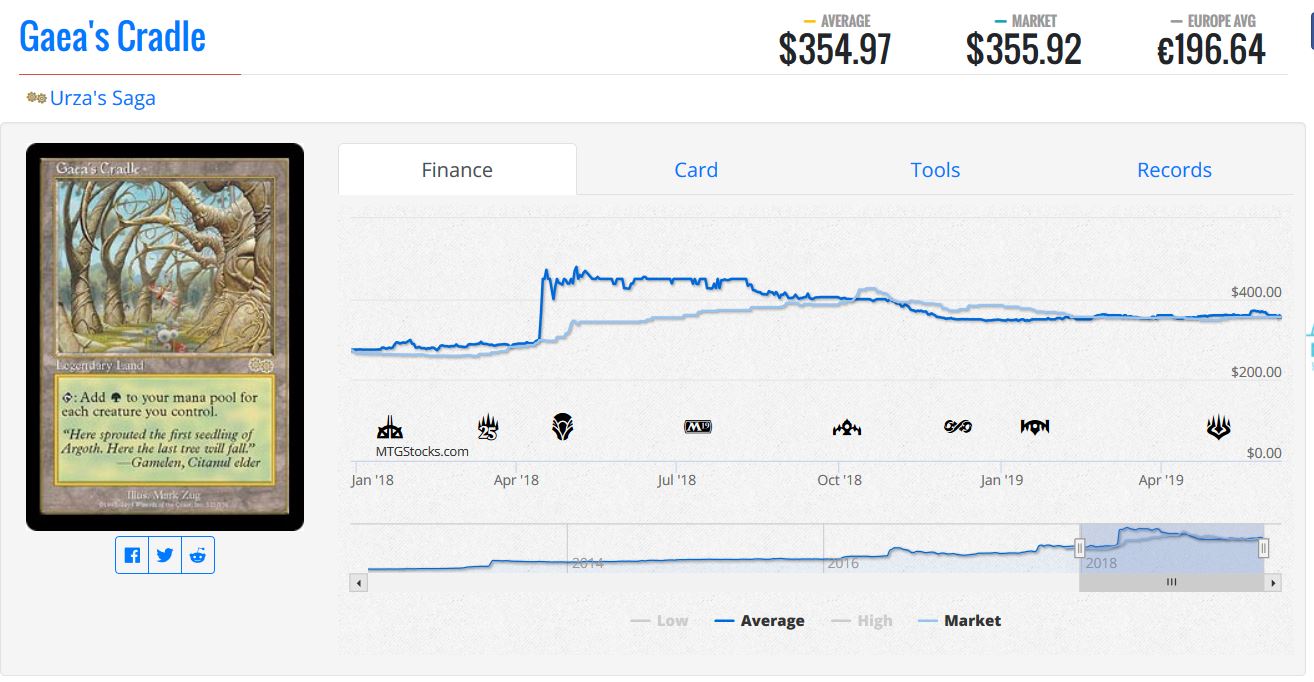Are you a Quiet Speculation member?
If not, now is a perfect time to join up! Our powerful tools, breaking-news analysis, and exclusive Discord channel will make sure you stay up to date and ahead of the curve.
Feedback continues to be positive on this Beating the Buyouts series. One reader cleverly pointed out that the one-week rule doesn’t really hold true for Reserved List cards. In fact, any cards that are older than 20 years won’t follow the one-week rule.
The reason is simple: the market supply on these cards is small and entrenched in collections and shoeboxes under beds that it takes longer for any response to a sudden spike in price. Whether the card spiking is a Dual Land or a Thought Lash, the time needed to return to equilibrium pricing—the pricing that the market is actually willing to support—is much greater.
Does that mean there are no tools in the arsenal for beating Reserved List buyouts? Is this a territory that MTG finance has already won, and everyone needs to just toss their arms in the air admitting defeat? Absolutely not! With older cards, more patience is required but it’s still possible to get ahead of the MTG finance crowd.
Breaking Down the Curve
Recall the general pattern for the buyout price curve: an exponential price increase followed by a one-week retraction of about 50% from peak. While results vary case by case, waiting one week before buying a spiked card is most often the correct approach.
Now let’s examine the buyout curve for something far older than Bearscape: Argivian Archaeologist. This is a good case study because the playability of this white creature isn’t so great. Therefore any price spikes are not due to sudden utility in gameplay—we’re looking at a strictly collectible card here, that has been manipulated by MTG speculation.
The card barely budged in price for many years. Then during the Reserved List rush of 2018, it spiked from $90 or so to north of $200. From there, the spike retracts, just like we saw with Bearscape last week. But instead of fully recovering in a week, we see in this case a short-term retraction followed by a long-term sell-off. Two weeks after the May 2nd spike, Argivian Archaeologist was already back down to $130 or so. Fast forward a year, and the card gradually settled right back down to its previous pre-spike price.
When MTG finance personalities claim that they don’t set the market price, it’s the player base who does, they’re not wrong. Since there was minimal “real” demand for this card—it was mostly Reserved List speculators—the price should not really have changed to begin with. Speculators tried to inflate the price, but the higher price wouldn’t stick. Thus, the market price prevails. But look how long it took to happen!
Readers may push back on this example. They may argue that a more playable card’s price does permanently increase after a buyout.
So let’s take a quick look at Gaea's Cradle, which was also swept away in the 2018 buyout craze.
Before the buyout, this was a $290 card. In April of last year, this land spiked to $430. Notice how this card’s chart deviates from that of Argivian Archaeologist. There’s virtually no short-term price retraction. There were enough FOMO (fear of missing out) buyers to sustain a $400 price tag, at least for a little while. After seven months, though, Gaea's Cradle dropped back below $400. It gradually declined until settling at around $355, where it is today. That’s about 20% higher than the pre-spiked price.
What does this mean? If there was no buyout driven by MTG finance, the natural price appreciation of this card would have probably been 22% over the course of the year. Instead of spiking and retracting, we would have seen a gradual incline as this card slowly gets absorbed into Commander decks and the like. The same end result was met, but we had to endure nearly a year of unnecessarily higher prices until the market could correct itself post-buyout.
Beating These Buyouts
This is where MTG finance can really put a sour taste in one’s mouth. Due to the rarity and age of these cards, buyouts cause a longer-lasting impact on the market. Whereas a newer card will sell off within a week, it could take months for a Reserved List card’s price to retract as much as it’s going to. Based on this data, I could recommend a one-year rule. If a Reserved List card is bought out, wait one year before buying.
That’s a long time to wait.
For those who don’t want to wait that long to acquire a Reserved List card (myself included), I have some good news! Reserved List cards haven’t spiked in a while and the one-year wait since the last spike has already passed! Anyone interested in purchasing a Reserved List card should rejoice that prices have all retracted already.
The less playable the Reserved List card, the greater the price has already retracted. If you need Dual Lands, of course, you’ll still be paying up. But even those are cheaper now than they were this time last year.
I wouldn’t wait too long, though, because prices on the most desirable Reserved List cards have already started to climb in recent weeks. I’ve noticed the return of multiple Dual Lands to Card Kingdom’s hotlist. They have also been increasing their price on Mox Diamond recently, mirroring its price appreciation over the past few weeks. I don’t know if there’s going to be a mad rush on these Reserved List cards, but if you were kicking yourself for missing out on a certain card last year you’d best shop around and prioritize acquisition soon.
My only other advice on beating these Reserved List buyouts is to leverage your current Magic assets. Card Kingdom has aggressive buylist prices, and I’m sure they’ll be paying top dollar on Modern Horizons cards once they come out. Modern staples, in general, sell fairly well. You can liquidate some extras and use the proceeds to acquire those few Reserved List cards you’re needing. It sure feels better acquiring a Dual Land with store credit than paying the cash price.
ABU Games has okay pricing on their heavily played Dual Lands. You could ship some foils or Old School cards they offer huge credit bonuses on to pick up a few. I’ve been doing this myself recently. And while paying $260 in store credit for an HP Revised Tropical Island feels wrong, the pain is mitigated when you’re getting $80 in store credit for a played Unlimited Two-Headed Giant of Foriys. Would you trade three played Giants for an HP Trop? I know I would!
Wrapping It Up
When a newer card is bought out, it’s relatively easy to keep emotions in check, wait a week, and enjoy a cheaper price. This happens in most cases where the buyout is artificial and driven by MTG finance speculation.
With Reserved List and older cards, however, this approach isn’t so painless. It can take up to a year for a card’s price to retract post-buyout. That’s a long time to sit on the sidelines waiting—either the higher price has to be paid or else the card remains out of reach for a long time. Neither of these scenarios are very attractive, and unfortunately, there’s little other advice I can offer.
But there’s good news! If you’re reading this article around the time of its writing, June 2019, then the one-year waiting period has already passed! Prices are retracted, and the dollars required to buy a Dual Land or Gaea's Cradle already matches with overall market sentiment. There are currently no emotions and no speculators artificially increasing prices…for now.
My intent isn’t to incite panic buyout or speculation. Far from it. But a savvy player has to realize that prices are favorable for buying right now. I can’t promise there will be another spike, but after this one year period of calm, it would behoove prospective buyers to shop around for cards this month and make a priority call. If you can’t do it with cash, then try to use other cards to acquire store credit, which in turn can be flipped into Reserved List cards. This is a less painful way of making these acquisitions.
Ignoring this opportunity is an option, and it may be perfectly fine for your life circumstances at this moment. But just be prepared for that inevitable spike. It happens time and again, and given Magic’s continued popularity, it would be foolish to think MTG speculation and buyouts are over. When the next round of Reserved List buyouts happen, you may be kicking yourself for not acting sooner.
At that point, you’ll just have to wait another year.
…
Sigbits
- As I mentioned in the article, Dual Lands are reappearing on Card Kingdom’s hotlist. Just this past week I saw Bayou and Tropical Island pop up on their list, with buy prices of $200 for each. I suspect there will be more to come as these are once again rebounding in price.
- Reserved List artifacts are also hot right now. Grim Monolith’s buy price is hitting new highs, now at $120 on Card Kingdom’s hotlist. Mox Diamond’s buy price is up to $185, the highest it’s been in a while. Lion's Eye Diamond is another one, though its buy price keeps fluctuating and is at $140 at the time of this writing.
- Two other Reserved List cards on the move are City of Traitors and Jihad. The former is a popular Legacy card, and its $145 buy price is truly merited. There aren’t many lands that tap for two mana right out the gate and even fewer that don’t hurt you when they tap. On the other hand, Jihad’s $130 buy price perplexes me. It’s an interesting card, but not all that useful. Perhaps this one is collector driven.







